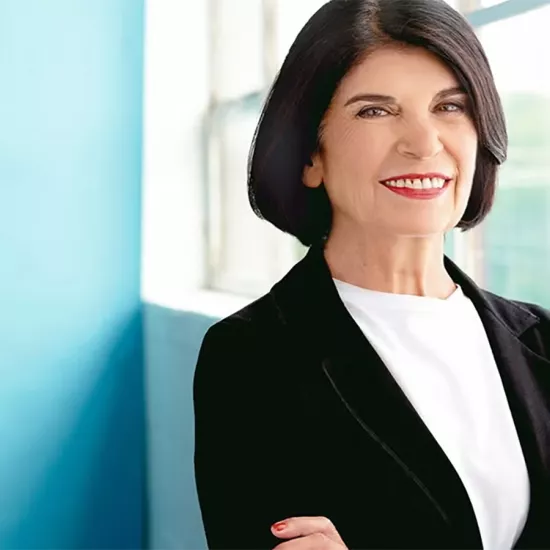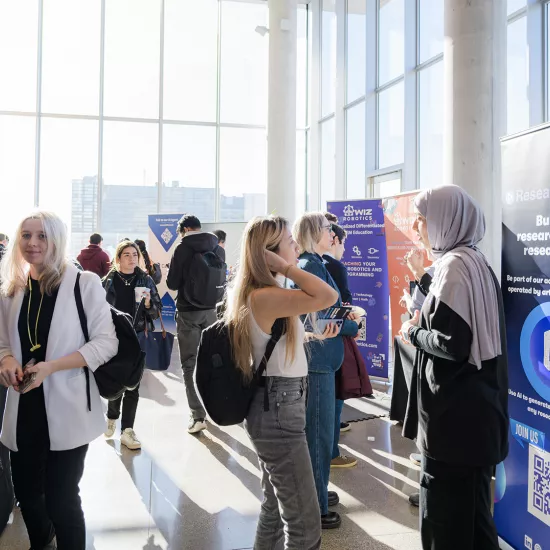UTM professor's work at Venice Biennale invites visitors to 'bear witness' to horrors of the past

On now at the 60th Venice Biennale — the Olympics of contemporary art, where leading artists from around the world showcase ambitious projects — you’ll find the work of University of Toronto alumna and professor Lilia Topouzova.
Inside Venice’s Centro Culturale Don Orione Artigianelli, a former monastery that hosts the art festival’s Bulgarian pavilion, the Bulgarian Canadian artist and scholar, alongside curator Vasil Vladimirov and Topouzova’s longtime collaborators, Krasimira Butseva and Julian Chehirian, present the multimedia installation The Neighbours: Forms of Trauma (1945-1989).
Financial Times recently named the pavilion, which is supported by U of T and Princeton University, a “highlight” of the festival. Now in its final month of exhibition, more than 55,000 visitors have already experienced its harrowing but powerful message.

The Neighbours draws on the collective’s scholarly research on political violence in Communist Bulgaria.
For more than 20 years, Topouzova has interviewed survivors of the Soviet gulags — work camps where political dissidents, artists, ethnic minorities, queer people and other “enemies of the state” were imprisoned without trial, she explains. Her findings are collected in the forthcoming book Unsilencing, which “lays the framework for the entire installation,” she says.
Composited from the hundreds of interviewee’s apartments that Topouzova, Butseva and Chehirian have visited, The Neighbours recreates the domestic space of a survivor of the forced labour camps. The space is divided into three rooms: the living room, the bedroom and the kitchen. As visitors explore the space, voices gradually become audible.
“[These are] the interviews of the people that we interviewed over the course of many years,” Topouzova explains. “And also very gradually, everything in the apartment — much like in an old-school [Andrei] Tarkovsky film — begins activating itself.” The sewing machine jumps to life; a record player begins to spin. The room is haunted by these difficult stories.
If the work sounds familiar, an earlier version was exhibited at U of T in September 2023 by the Munk School of Global Affairs & Public Policy in collaboration with Soulpepper Theatre and the Jackman Humanities Institute. That installation recently won a Toronto Heritage People’s Choice Award.
Like the mementos and souvenirs people use to decorate their homes, the installation’s rooms hold material reminders salvaged from the work camps, such as sticks, rocks and water from the Danube River, where one of the biggest camps was located. The researchers would regularly find similar homemade memorials in the homes of survivors. “Not often – always,” Topouzova emphasizes. “It was remarkable.”

She recalls an interview by Butseva with a man who’d survived “one of the more violent camps.” They found a piece of earth in one his drawers that he’d quickly pocketed before leaving, “so that he himself could believe that this truly happened to him,” Topouzova says.
There is no public memorial for these atrocities, she continues. The sites of the camps are unmarked. “The archives were purged,” she says, “and so they only exist in interior spaces, like these people's homes.”
Researchers dedicated to the same subject, Topouzova, Butseva and Chehirian began working together 10 years ago, after each had encountered the “limit” of their respective disciplines. Presenting their findings here as an artwork invites visitors to “bear witness” to the testimonies just as the researchers encountered them, Topouzova says.
“People actually sit down and experience it as if they are the ethnographer, as if they are the ones asking the questions, which is quite different from reading a book or watching a film,” she says.
“Before we begin understanding these stories, we actually need to hear them and feel them. And so I think that academic discourses that exist today, academic practices as they exist today, are a little empty of the ability to allow people to feel things.”

The Neighbours is an experimental presentation of scholarly research that allows visitors to make such deeper connections.
Topouzova sees the project as a direct relative to her work on campus. Joining UTM six years ago, the artist-scholar teaches creative non-fiction, narrative storytelling and documentary film practices at the Institute of Communication, Culture, Information and Technology as well as the history of state socialism, communism and political violence in the 20th century at the Munk School’s Centre for European and Eurasian Studies.
“At UTM, I work in an interdisciplinary unit where all of us are scholars, but also practitioners, either of art or media.” she says. “So I see it as a kind of seamless extension of my work. I teach my classes in a classroom, on the field and in a video editing lab. So in a sense, my artistic and scholarly practice and my teaching practice completely overlap.”



